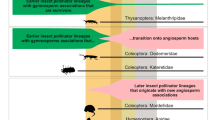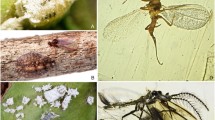Abstract
Diversification in insects has often been linked to the evolution of angiosperms. The majority of studies reporting this link, however, have been done on herbivorous insects. It remains unclear if the diversification of angiosperms was also influential in the diversification of species-rich, carnivorous insect groups. Here we investigate the timing of the origin and diversification in the stinging wasps (Hymenoptera: Aculeata). We employ a Bayesian Markov chain Monte Carlo relaxed clock approach to estimate divergence times for 13 wasp families and eight superfamilies. Divergence times are calibrated with 12 fossils representing groups in various lineages. Our results indicate that many of the modern aculeate families originated during the Cretaceous and in concert with the diversification of angiosperms. This similarity between diversification ages in wasps and in angiosperms may be due to an increased habitat complexity and prey diversity that early angiosperm forests provided.


Similar content being viewed by others

References
Bell, C. D., Soltis, D. E., & Soltis, P. S. (2010). The age and diversification of the angiosperms re-revisited. American Journal of Botany, 97, 1296–1303.
Brady, S. G., Larkin, L., & Danforth, B. N. (2009). Bees, ants, and stinging wasps (Aculeata). In S. B. Hedges & S. Kumar (Eds.), The timetree of life (pp. 264–269). New York: Oxford University Press.
Brady, S. G., Schultz, T. R., Fisher, B. L., & Ward, P. S. (2006). Evaluating alternative hypotheses for the early evolution and diversification of ants. Proceedings of the National Academy of Sciences, 103, 18172–18177.
Brothers, D. J. (2003). The first fossil Ephutini (Hymenoptera: Mutillidae), a new species of Ephuta SAY from Dominican amber. Acta Zoologica Cracoviensia, 46, 101–107.
Carpenter, J. M., & Rasnitsyn, A. P. (1990). Mesozoic Vespidae. Psyche, 97, 1–20.
Cockerell, T. (1917). Arthropods in Burmese amber. Psyche, 24, 40–44.
Cooper, A., & Fortey, R. (1998). Evolutionary explosions and the phylogenetic fuse. Trends in Ecology & Evolution, 13, 151–156.
Danforth, B. N., Brady, S. G., Sipes, S. D., & Pearson, A. (2004). Single-copy nuclear genes recover Cretaceous-age divergences in bees. Systematic Biology, 53, 309–326.
Danforth, B. N., & Poinar, G. O. (2011). Melittosphex burmensis (Apoidea: Melittosphecidae): Detailed description of the morphology, classification, antiquity, and implications for bee evolution. Journal of Paleontology, 85, 882–891.
Drummond, A. J., & Rambaut, A. (2007). BEAST: Bayesian evolutionary analysis by sampling trees. BMC Evolutionary Biology, 7, 214.
Engel, M. S. (2000). A new interpretation of the oldest fossil bee (Hymenoptera: Apidae). American Museum Novitates, 3296, 1–11.
Foottit, R. G., & Adler, P. H. (2009). Insect biodiversity: Science and society. New York: Blackwell Publishing.
Forister, M. L., & Feldman, C. R. (2011). Phylogenetic cascades and the origins of tropical diversity. Biotropica, 43, 270–278.
Genise, J. F., & Verde, M. (2000). Corimbatichnus fernandezi: A cluster of fossil bee cells from the late cretaceous-early tertiary of Uruguay. Ichnos, 7, 115–125.
Goulet, H., & Huber, J. T. (1993). Hymenoptera of the world: an identification guide to families. Ottawa: Agriculture Canada.
Grimaldi, D. (1999). The co-radiations of pollinating insects and angiosperms in the Cretaceous. Annals of the Missouri Botanical Garden, 86, 373–406.
Grimaldi, D., & Agosti, D. (2000). A formicine in New Jersey Cretaceous amber (Hymenoptera: Formicidae) and early evolution of the ants. Proceedings of the National Academy of Sciences, 97, 13678.
Grimaldi, D., & Engel, M. S. (2005). Evolution of the insects. New York: Cambridge University Press.
Grimaldi, D. A., Maisey, J. G., McCafferty, W. P., Carle, F. L., Wighton, D. C., Popham, E. J., et al. (1990). Insects from the Santana Formation, Lower Cretaceous, of Brazil. Bulletin of the American Museum of Natural History, 195, 123–153.
Lelej, A. (1986). Males of the genus Protomutilla (Hymenoptera, Mutillidae) from Baltic amber. Paleontologicheskiy Zhurnal, 4, 104–106.
Michener, C. D., & Grimaldi, D. A. (1988). A Trigona from Late Cretaceous Amber of New Jersey (Hymenoptera: Apidae: Meliponinae). American Museum Novitates, 2917, 1–10.
Michez, D., Vanderplanck, M., & Engel, M. S. (2012). Fossil bees and their plant associates. In S. Patiny (Ed.), Evolution of plant-pollinator relationships. Cambridge: Cambridge University Press.
Moreau, C. S., Bell, C. D., Vila, R., Archibald, S. B., & Pierce, N. E. (2006). Phylogeny of the ants: Diversification in the age of angiosperms. Science, 312, 101.
Ober, K., & Heider, T. (2010). Phylogenetic diversification patterns and divergence times in ground beetles (Coleoptera: Carabidae: Harpalinae). BMC Evolutionary Biology, 10, 262.
Penney, D. (2004). Does the fossil record of spiders track that of their principal prey, the insects. Transactions of the Royal Society of Edinburgh, Earth Sciences, 94, 275–281.
Pie, M. R., & Tschá, M. K. (2009). The macroevolutionary dynamics of ant diversification. Evolution, 63, 3023–3030.
Pilgrim, E. M., Von Dohlen, C. D., & Pitts, J. P. (2008). Molecular phylogenetics of Vespoidea indicate paraphyly of the superfamily and novel relationships of its component families and subfamilies. Zoologica Scripta, 37, 539–560.
Pitts, J. P., Wilson, J. S., & von Dohlen, C. D. (2010). Evolution of the nocturnal Nearctic Sphaeropthalminae velvet ants (Hymenoptera: Mutillidae) driven by Neogene orogeny and Pleistocene glaciation. Molecular Phylogenetics and Evolution, 56, 134–145.
Poinar, G., & Danforth, B. (2006). A fossil bee from Early Cretaceous Burmese amber. Science, 314, 614.
Rambaut, A., & Drummond, A. J. (2007). Tracer v1.5. http://beast.bio.ed.ac.uk/Tracer.
Rasnitsyn, A. (1986). Review of the fossil Tiphiidae, with description of a new species (Hymenoptera). Psyche, 93, 91–102.
Rasnitsyn, A. P. (2000). An extremely primitive aculeate wasp in the Cretaceous amber from New Jersey (Vespida: ?Sierolomorphidae). In D. Grimaldi (Ed.), Studies on fossils in amber, with particular reference to the Cretaceous of New Jersey (pp. 327–332). Leiden, The Netherlands: Backhuys Publishers.
Sanderson, M. J. (2002). Estimating absolute rates of molecular evolution and divergence times: A penalized likelihood approach. Molecular Biology and Evolution, 19, 101–109.
Schneider, H., Schuettpelz, E., Pryer, K. M., Cranfill, R., Magallón, S., & Lupia, R. (2004). Ferns diversified in the shadow of angiosperms. Nature, 428, 553–557.
Selden, P. A., Shear, W. A., & Bonamo, P. M. (1991). A spider and other arachnids from the Devonian of New York, and reinterpretations of Devonian Araneae. Palaeontology, 34, 241–281.
Shapiro, B., Rambaut, A., & Drummond, A. J. (2006). Choosing appropriate substitution models for the phylogenetic analysis of protein-coding sequences. Molecular Biology and Evolution, 23, 7–9.
Weitschat, W., & Wichard, W. (2002). Atlas of plants and animals in Baltic amber. Munich, Germany: Verlag Dr. Friedrich Pfeil.
Acknowledgments
This research was supported by the Utah Agricultural Experiment Station, Utah State University, Logan, Utah, and is approved as journal paper no. 8372. This work was also supported by the National Science Foundation award DEB-0743763 to JPP and CDvD and DEB-1020509 and DEB-1050726 to MLF.
Author information
Authors and Affiliations
Corresponding author
Rights and permissions
About this article
Cite this article
Wilson, J.S., von Dohlen, C.D., Forister, M.L. et al. Family-Level Divergences in the Stinging Wasps (Hymenoptera: Aculeata), with Correlations to Angiosperm Diversification. Evol Biol 40, 101–107 (2013). https://doi.org/10.1007/s11692-012-9189-0
Received:
Accepted:
Published:
Issue Date:
DOI: https://doi.org/10.1007/s11692-012-9189-0



